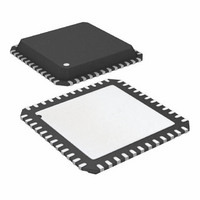ADUC7034BCPZ-RL Analog Devices Inc, ADUC7034BCPZ-RL Datasheet - Page 46

ADUC7034BCPZ-RL
Manufacturer Part Number
ADUC7034BCPZ-RL
Description
IC,Battery Management,LLCC,48PIN,PLASTIC
Manufacturer
Analog Devices Inc
Series
MicroConverter® ADuC7xxxr
Datasheet
1.ADUC7034BCPZ-RL.pdf
(136 pages)
Specifications of ADUC7034BCPZ-RL
Core Processor
ARM7
Core Size
16/32-Bit
Speed
20.48MHz
Connectivity
LIN, SPI, UART/USART
Peripherals
POR, PSM, Temp Sensor, WDT
Number Of I /o
9
Program Memory Size
32KB (32K x 8)
Program Memory Type
FLASH
Ram Size
4K x 8
Voltage - Supply (vcc/vdd)
3.5 V ~ 18 V
Data Converters
A/D 2x16b
Oscillator Type
Internal
Operating Temperature
-40°C ~ 115°C
Package / Case
48-LFCSP
Lead Free Status / RoHS Status
Lead free / RoHS Compliant
Eeprom Size
-
Lead Free Status / RoHS Status
Lead free / RoHS Compliant
ADuC7034
ADC Mode Register
Name:
Address:
Default Value:
Access:
Function:
Table 35. ADCMDE MMR Bit Designations
Bit
7
6
5
4 to 3
2 to 0
ADCMDE
0xFFFF0508
0x00
Read/write
The ADC mode MMR is an 8-bit register that configures the mode of operation of the ADC subsystem.
Description
Not used. This bit is reserved for future functionality and should be written as 0 by user code.
20 kΩ resistor select.
1 = selects the 20 kΩ resistor shown in Figure 20.
0 = selects the direct path to ground shown in Figure 20 (default).
Low power mode reference select.
1 = enables the precision voltage reference in either low power mode or low power plus mode. Enabling the precision
voltage reference in low power modes requires additional current and therefore results in increased current consumption.
0 = enables the low power voltage reference in either low power mode or low power plus mode (default).
ADC power mode configuration.
00 = ADC normal mode. If enabled, the ADC operates with normal current consumption, yielding optimum electrical
performance.
01 = ADC low power mode. If enabled, the I-ADC operates with reduced current consumption. This limitation in current
consumption is achieved, but at the expense of degrading ADC noise performance, by fixing the gain to 128 and using
the on-chip low power 131 kHz oscillator to directly drive the ADC circuits.
10 = ADC low power plus mode. If this bit is enabled, the ADC operates with reduced current consumption. In this
mode, the gain is fixed to 512 and the current consumed is approximately 200 μA more than the ADC low power mode.
The additional current consumed also ensures that the ADC noise performance is better than that achieved in ADC low
power mode.
11 = not defined.
ADC operation mode configuration.
000 = ADC power-down mode. All ADC circuits, including the internal reference, are powered down.
001 = ADC continuous conversion mode. In this mode, any enabled ADC continuously converts.
010 = ADC single conversion mode. In this mode, any enabled ADC performs a single conversion. The ADC enters idle
mode when the single conversion is complete. A single conversion takes two to three ADC clock cycles, depending on the
chop mode.
011 = ADC idle mode. In this mode, the ADC is fully powered on but is held in reset.
100 = ADC self-offset calibration. In this mode, an offset calibration is performed on any enabled ADC using an internally
generated 0 V. The calibration is carried out at the user programmed ADC settings; therefore, as with a normal single ADC
conversion, it takes two to three ADC conversion cycles before a fully settled calibration result is ready. The calibration result is
automatically written to the ADCxOF MMR of the respective ADC. The ADC returns to idle mode and the calibration and
conversion ready status bits are set at the end of an offset calibration cycle.
101 = ADC self-gain calibration. In this mode, a gain calibration to an internal reference voltage is performed on all enabled
ADCs. A gain calibration is a two-stage process and takes twice the time of an offset calibration. The calibration result is
automatically written to the ADCxGN MMR of the respective ADC. The ADC returns to idle mode, and the calibration and
conversion ready status bits are set at the end of a gain calibration cycle. An ADC self-gain calibration should only be
performed on the current channel ADC. Preprogrammed, factory-set calibration coefficients (downloaded automatically
from internal Flash/EE) should be used for voltage temperature measurements. If an external NTC is used, an ADC self-
calibration should be performed on the temperature channel.
110 = ADC system zero-scale calibration. In this mode, a zero-scale calibration is performed on enabled ADC channels
to an external zero-scale voltage driven at the ADC input pins. The calibration is performed at the user programmed
ADC settings; therefore, as with a single ADC conversion, three ADC conversion cycles are required before a fully settled
calibration result is available.
111 = ADC system full-scale calibration. In this mode, a full-scale calibration is performed on enabled ADC channels to
an external full-scale voltage driven at the ADC input pins.
Rev. B | Page 46 of 136












